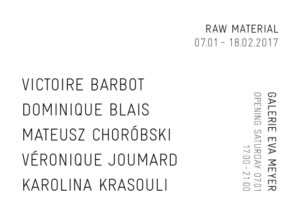RAW MATERIAL

GALERIE EVA MEYER, 01/07/2017 - 02/18/2017
5 rue des Haudriettes F-75003 Paris
The group exhibition Raw Material is an invitation, an experiment, an encounter. Five artists of different generations are invited to invest the gallery for the first time.
This exhibition is built around the implicit correspondences among the practices of each of the artists. Research, often experimental, taking two routes. The first, that of the materialization of elements lacking physical existence: time, energy, memory, language. The second, that of the attention paid to intrinsic properties of certain materials become the constituent part of the artwork: glass, copper, fabric, body.
Each work requires a resting of the gaze, to adjust one’s focus to take in the latent potentialities, the force fields, and the energies at rest. Certain practices are reminiscent of questions dear to Minimal or Conceptual Art, allowing the insertion of this proposition in a long reflexive tradition on the material of art, from its essence to its dematerialization.
Mateusz Choróbski’s The long day's journey into the night (2016)plunges the gallery’s main room into darkness, in a muted ambiance resulting from re-working each neon into a dulled luminosity. Each tube Is covered with debris of recuperated glass from Warsaw, the ruins of the old National Mint, destroyed several months earlier. The two-way mirrored windows of the building blocked the view of passer-bys. Mateusz Choróbski’s work concentrates on our perception of the object, instrument of monstration usually strictly function, tending to become invisible. The historical and political context of glass broken then concentrated, becomes, in accordance with the quality of the luminous support, a paradoxical discourse on the notions of transparency, clarity, opacity and conversion.
On a shelf become horizon line, Véronique Joumard draws forms appearing as much vegetal as animal, micro-landscapes recalling that “the miniature is one of the dwellings of grandeur”[1]. This play on volumes crafted by the force of magnets and iron fillings allows for glimpses, through the voluntarily visible dispositive, of the possibilities of activation and movements of the material. Magnetic Landscape (2016) takes into account the economy of method and the physical fragility of the artwork as well as the general practice of Véronique Joumard, in her experimenting of intangible materials “proceeding in the manner of a scientist concentrating on phenomena, she transforms terrestrial material into inventions”[2]. Also presented in the exhibition space, Clock (2002) is animated by a single hand: the second. This infinite cycle of seconds makes the object completely dysfunctional, the passing by of time and its perception completely escaping us.
Dominique Blais’s Entropê (2014-2015) plays on the ambivalence between materials’ form and property. This work realized by the artist during a residency at CIRVA highlights the work of the glass-blower as much as the paradoxical properties of the material, being both an insulator and conductor of electricity, depending on the temperature. The obtained form is reminiscent of an isolator, an element found in high-voltage power lines, but also evokes a spinning top, presented here as if its movement was frozen. This work seems to be paused at a transitory step, as if suspended between two states. The flux of energy is contained, retained in the glass become an isolator, even though the sheet of polished copper on which it is placed is thought to be the energy vector par excellence.
An encounter with material is also the origin of Victoire Barbot’s Grey Paintings [3 panels] (2016). Practiced in working with recuperated materials, fabric and more specifically velvet, are an integral element of her practice. Used first in the form of rolls or lengths in her sculptures, velvet appears here for the first time as a two-dimensional work. Grey Paintings [3 panels] is composed of three lengths of velvet stretched by the artist into the wall itself. This gesture of installation recorded by the fabric becomes the motif of the piece. Victoire Barbot reactivates, with the help of the title and dimensions, Robert Rauschenberg’s White Paintings (1951).
Karolina Krasouli establishes a visual research based on “Gorgeous Nothings”, Emily Dickinson’s poems written on envelopes (1830-1886). The envelope thus becomes a motif used by the artist to its exhaustion. First in the form of a mural installation, the object multiplies, cuts, colors, transforms into a cryptic language. The artist then inserts this form into her panting in different forms. Untitled (2016) allows us to apprehend the object, become a pictorial material, a kind of ideogram floating at the heart of this composition made up of countless layers of gesso and pigments.
The ensemble of videos produced by Karolina Krasouli is filmed in Super 8, allowing her to work on the film itself during post-production. Score (2016) brings us into the daily life of dancers as they rehearse. The hand quickly substitutes in for the body and acts as an activator of memory. The repeated gesture takes the form of a language accentuated by the absence of a soundtrack.
For More Information